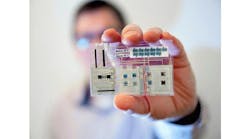Demand for active and intelligent packaging in the U.S. is forecast to expand 7.3% annually to $4.0 billion in 2019, well above the packaging industry average, according to the Fredonia Group.
Active packaging is broadly defined as packaging that performs a function beyond the protection and identification of its contents. Intelligent packaging refers to packaging technology that provides external data and/or relays information relative to the status of the contents.
Product segments covered include gas scavengers, corrosion control packaging, moisture control packaging, susceptor packaging, other active packaging (e.g., antimicrobial packaging, self-venting and air-releasing packaging), color indicating packaging, time-temperature indicators (TTIs), smartphone-enabled interactive packaging, and other intelligent packaging (e.g., pharmaceutical compliance packaging, assistive packaging).
Markets for these products include food, beverages, pharmaceuticals, primary metals, motor vehicles, electronics, and other (e.g., industrial machinery, military equipment and supplies, diagnostic and medical equipment).
While many active and intelligent packaging products, such as packaged desiccants and volatile corrosion inhibitors, have a well-established presence, emerging products include antimicrobial packaging, advanced time-temperature monitors, and smartphone-enabled interactive packaging products.
Intelligent packaging demand will see the faster growth as products such as time-temperature indicators and smart labels and tags become more common. The development of technology which allows for low cost production of printed electronics and the elimination of specialized electronic readers in favor of smartphones will allow them to enter the mainstream. Rapid adoption of tracking-enabled or interactive packaging components will be driven by recent legislation in the pharmaceutical and food markets requiring producers to take steps to make products safer and easier to recall.



